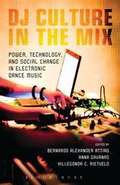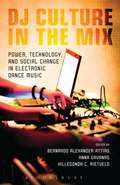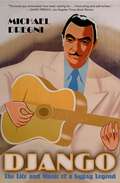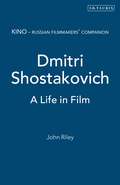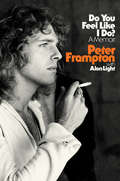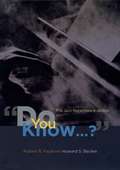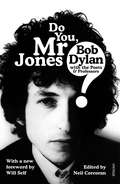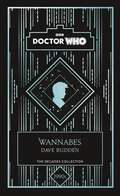- Table View
- List View
DJ Culture in the Mix: Power, Technology, and Social Change in Electronic Dance Music (PDF)
by Bernardo Alexander Attias Bernardo Attias Anna Gavanas Hillegonda C. Rietveld Hillegonda RietveldThe DJ stands at a juncture of technology, performance and culture in the increasingly uncertain climate of the popular music industry, functioning both as pioneer of musical taste and gatekeeper of the music industry. Together with promoters, producers, video jockeys (VJs) and other professionals in dance music scenes, DJs have pushed forward music techniques and technological developments in last few decades, from mashups and remixes to digital systems for emulating vinyl performance modes. This book is the outcome of international collaboration among academics in the study of electronic dance music. Mixing established and upcoming researchers from the US, Canada, the UK, Germany, Austria, Sweden, Australia and Brazil, the collection offers critical insights into DJ activities in a range of global dance music contexts. In particular, chapters address digitization and performativity, as well as issues surrounding the gender dynamics and political economies of DJ cultures and practices.
DJ Culture in the Mix: Power, Technology, and Social Change in Electronic Dance Music
by Anna Gavanas Bernardo Attias Hillegonda RietveldThe DJ stands at a juncture of technology, performance and culture in the increasingly uncertain climate of the popular music industry, functioning both as pioneer of musical taste and gatekeeper of the music industry. Together with promoters, producers, video jockeys (VJs) and other professionals in dance music scenes, DJs have pushed forward music techniques and technological developments in last few decades, from mashups and remixes to digital systems for emulating vinyl performance modes. This book is the outcome of international collaboration among academics in the study of electronic dance music. Mixing established and upcoming researchers from the US, Canada, the UK, Germany, Austria, Sweden, Australia and Brazil, the collection offers critical insights into DJ activities in a range of global dance music contexts. In particular, chapters address digitization and performativity, as well as issues surrounding the gender dynamics and political economies of DJ cultures and practices.
DJ Culture in the Mix: Power, Technology, and Social Change in Electronic Dance Music
by Anna Gavanas Bernardo Attias Hillegonda RietveldThe DJ stands at a juncture of technology, performance and culture in the increasingly uncertain climate of the popular music industry, functioning both as pioneer of musical taste and gatekeeper of the music industry. Together with promoters, producers, video jockeys (VJs) and other professionals in dance music scenes, DJs have pushed forward music techniques and technological developments in last few decades, from mashups and remixes to digital systems for emulating vinyl performance modes. This book is the outcome of international collaboration among academics in the study of electronic dance music. Mixing established and upcoming researchers from the US, Canada, the UK, Germany, Austria, Sweden, Australia and Brazil, the collection offers critical insights into DJ activities in a range of global dance music contexts. In particular, chapters address digitization and performativity, as well as issues surrounding the gender dynamics and political economies of DJ cultures and practices.
DJ Shadow's Endtroducing (33 1/3)
by Eliot WilderWhat resonated about Endtroducing when it was released in 1996, and what makes it still resonate today, is the way in which it loosens itself from the mooring of the known and sails off into an uncharted territory that seems to exist both in and out of time. Josh Davis is not only a master sampler and turntablist supreme, he is also a serious archeologist with a world-thirsty passion (what Cut Chemist refers to as Josh's "spidey sense") for seeking out, uncovering and then ripping apart the discarded graces of some other generation - that "pile of broken dreams" - and weaving them back together into a tapestry of chronic bleakness and beauty.Over the course of several long conversations with Josh Davis (DJ Shadow), we learn about his early years in California, the friends and mentors who helped him along the way, his relationship with Mo'Wax and James Lavelle, and the genesis and creation of his widely acknowledged masterpiece, Endtroducing.
Django: The Life and Music of a Gypsy Legend
by Michael DregniDjango Reinhardt was arguably the greatest guitarist who ever lived, an important influence on Les Paul, Charlie Christian, B.B. King, Jerry Garcia, Chet Atkins, and many others. Yet there is no major biography of Reinhardt. Now, in Django, Michael Dregni offers a definitive portrait of this great guitarist. Handsome, charismatic, childlike, and unpredictable, Reinhardt was a character out of a picaresque novel. Born in a gypsy caravan at a crossroads in Belgium, he was almost killed in a freak fire that burned half of his body and left his left hand twisted into a claw. But with this maimed left hand flying over the frets and his right hand plucking at dizzying speed, Django became Europe's most famous jazz musician, commanding exorbitant fees--and spending the money as fast as he made it. Dregni not only chronicles this remarkably colorful life--including a fascinating account of gypsy culture--but he also sheds much light on Django's musicianship. He examines his long musical partnership with violinist Stéphane Grappelli--the one suave and smooth, the other sharper and more dissonant--and he traces the evolution of their novel string jazz ensemble, Quintette du Hot Club de France. Indeed, the author spotlights Django's amazing musical diversity, describing his swing-styled Nouveau Quintette, his big band Django's Music, and his later bebop ensemble, as well as his many compositions, including symphonic pieces influenced by Ravel and Debussy and his unfinished organ mass inspired by Bach. And along the way, the author offers vivid snapshots of the jazz scene in Paris--colorful portraits of Josephine Baker, Bricktop, Louis Armstrong, Coleman Hawkins, and countless others--and of Django's vagabond wanderings around France, Europe, and the United States, where he toured with Duke Ellington. Capturing the extraordinary life and times of one of the great musicians of the twentieth century, Django is a must-read portrait of a true original.
Django: The Life and Music of a Gypsy Legend
by Michael DregniDjango Reinhardt was arguably the greatest guitarist who ever lived, an important influence on Les Paul, Charlie Christian, B.B. King, Jerry Garcia, Chet Atkins, and many others. Yet there is no major biography of Reinhardt. Now, in Django, Michael Dregni offers a definitive portrait of this great guitarist. Handsome, charismatic, childlike, and unpredictable, Reinhardt was a character out of a picaresque novel. Born in a gypsy caravan at a crossroads in Belgium, he was almost killed in a freak fire that burned half of his body and left his left hand twisted into a claw. But with this maimed left hand flying over the frets and his right hand plucking at dizzying speed, Django became Europe's most famous jazz musician, commanding exorbitant fees--and spending the money as fast as he made it. Dregni not only chronicles this remarkably colorful life--including a fascinating account of gypsy culture--but he also sheds much light on Django's musicianship. He examines his long musical partnership with violinist Stéphane Grappelli--the one suave and smooth, the other sharper and more dissonant--and he traces the evolution of their novel string jazz ensemble, Quintette du Hot Club de France. Indeed, the author spotlights Django's amazing musical diversity, describing his swing-styled Nouveau Quintette, his big band Django's Music, and his later bebop ensemble, as well as his many compositions, including symphonic pieces influenced by Ravel and Debussy and his unfinished organ mass inspired by Bach. And along the way, the author offers vivid snapshots of the jazz scene in Paris--colorful portraits of Josephine Baker, Bricktop, Louis Armstrong, Coleman Hawkins, and countless others--and of Django's vagabond wanderings around France, Europe, and the United States, where he toured with Duke Ellington. Capturing the extraordinary life and times of one of the great musicians of the twentieth century, Django is a must-read portrait of a true original.
Django Generations: Hearing Ethnorace, Citizenship, and Jazz Manouche in France (Chicago Studies in Ethnomusicology)
by Siv B. LieDjango Generations shows how relationships between racial identities, jazz, and national belonging become entangled in France. Jazz manouche—a genre known best for its energetic, guitar-centric swing tunes—is among France’s most celebrated musical practices of the twentieth and twenty-first centuries. It centers on the recorded work of famed guitarist Django Reinhardt and is named for the ethnoracial subgroup of Romanies (also known, often pejoratively, as “Gypsies”) to which Reinhardt belonged. French Manouches are publicly lauded as bearers of this jazz tradition, and many take pleasure and pride in the practice while at the same time facing pervasive discrimination. Jazz manouche uncovers a contradiction at the heart of France’s assimilationist republican ideals: the music is portrayed as quintessentially French even as Manouches themselves endure treatment as racial others. In this book, Siv B. Lie explores how this music is used to construct divergent ethnoracial and national identities in a context where discussions of race are otherwise censured. Weaving together ethnographic and historical analysis, Lie shows that jazz manouche becomes a source of profound ambivalence as it generates ethnoracial difference and socioeconomic exclusion. As the first full-length ethnographic study of French jazz to be published in English, this book enriches anthropological, ethnomusicological, and historical scholarship on global jazz, race and ethnicity, and citizenship while showing how music can be an important but insufficient tool in struggles for racial and economic justice.
DJing For Dummies
by John SteventonHow to start and build a successful career as a DJ-from at-home mixing to making demos to playing to a live crowd Whether it's a digital or vinyl track of "Proud Mary," a DJ sets the mood, amps up the excitement, and gets a crowd of revelers rockin'. Often an outsized personality, blessed with a gorgeous voice and an encyclopedic knowledge of music, a DJ is this era's new pop star. For those interested in how to begin a career as a DJ, DJing For Dummies offers newcomers all the technical know-how needed as well as advice on how to create your own DJing style and how to make DJing work for you. With tips on equipment essentials, such as turntables, slipmats and needles, headphones, and amplifiers, as well as buying records, CDs, and MP3s, this practical guide takes you through the basics of mixing, song structure, building a foolproof set, creating a great demo, and what to do when you finally face a live audience. Includes ten resources for expanding your skills and fan base With invaluable advice on ten DJing mistakes to avoid as well as answers to DJ questions you're too afraid to ask Includes updated info on the latest software and techniques, expanded content on digital DJing, and DJing over the Internet With tips on the ten items to take with you when you get a gig, as well as how to DJ at a wedding, DJing For Dummies will help turn your fantasy into an exciting and fun, money-making career.
DJing For Dummies
by John SteventonHow to start and build a successful career as a DJ-from at-home mixing to making demos to playing to a live crowd Whether it's a digital or vinyl track of "Proud Mary," a DJ sets the mood, amps up the excitement, and gets a crowd of revelers rockin'. Often an outsized personality, blessed with a gorgeous voice and an encyclopedic knowledge of music, a DJ is this era's new pop star. For those interested in how to begin a career as a DJ, DJing For Dummies offers newcomers all the technical know-how needed as well as advice on how to create your own DJing style and how to make DJing work for you. With tips on equipment essentials, such as turntables, slipmats and needles, headphones, and amplifiers, as well as buying records, CDs, and MP3s, this practical guide takes you through the basics of mixing, song structure, building a foolproof set, creating a great demo, and what to do when you finally face a live audience. Includes ten resources for expanding your skills and fan base With invaluable advice on ten DJing mistakes to avoid as well as answers to DJ questions you're too afraid to ask Includes updated info on the latest software and techniques, expanded content on digital DJing, and DJing over the Internet With tips on the ten items to take with you when you get a gig, as well as how to DJ at a wedding, DJing For Dummies will help turn your fantasy into an exciting and fun, money-making career.
DJing for Dummies
by John SteventonFrom novice to nightclub -- without the nightmares. Whether you're a bedroom DJ looking to improve, or an accomplished amateur making the transition to playing live, DJing For Dummies has the accessible information you need. From what to buy (and what not to buy), mastering the beat, and reading a crowd, to all the tricks, techniques, and flourishes of a pro DJ, you'll be turning noise into notoriety in no time. Discover how to: * Buy the essential equipment * Set up your kit * beatmatch seamlessly * scratch with vinyl and CD * make a great demo * Market yourself as a DJ * Explanations in plain English ' * Get in get out' information * Icons and other navigational aids * Tear-out cheat sheet * Top ten lists * A dash of humour and fun Get Smart!@www.dummies.com * Find listings of all our books * Choose from many different subject categories * Browse out free articles
DJing For Dummies (For Dummies Ser.)
by John SteventonDJ like a pro—without skipping a beat The bestselling guide to spinning and scratching is back! If you've ever spent hours in your bedroom with two turntables and an earful of tracks that sound off-beat or out of key, DJing For Dummies is the go-to guide for taking your skills to the next level. Inside, John Steventon, a successful club DJ, walks you through the basics of mixing, the techniques and tricks you need to create your own DJ style and how to make DJing work for you. Covering both digital and old-school vinyl-based instruction, this guide covers all the latest DJ technology, equipment and software so you can get mixing and stay one step ahead of the crowd. Brimming with expert advice and easy-to-follow explanations, the information in DJing For Dummies gives you everything you need to build a foolproof set and play to a live crowd. Nail down the basics and build on existing skills Sort through the latest equipment and technology Have a go at crossfading, beatmatching and scratching Mix tracks seamlessly to sound like a pro If you're new to the game or looking to step up your skills and graduate to club work, DJing For Dummies has you covered.
DJing For Dummies
by John SteventonDJ like a pro—without skipping a beat The bestselling guide to spinning and scratching is back! If you've ever spent hours in your bedroom with two turntables and an earful of tracks that sound off-beat or out of key, DJing For Dummies is the go-to guide for taking your skills to the next level. Inside, John Steventon, a successful club DJ, walks you through the basics of mixing, the techniques and tricks you need to create your own DJ style and how to make DJing work for you. Covering both digital and old-school vinyl-based instruction, this guide covers all the latest DJ technology, equipment and software so you can get mixing and stay one step ahead of the crowd. Brimming with expert advice and easy-to-follow explanations, the information in DJing For Dummies gives you everything you need to build a foolproof set and play to a live crowd. Nail down the basics and build on existing skills Sort through the latest equipment and technology Have a go at crossfading, beatmatching and scratching Mix tracks seamlessly to sound like a pro If you're new to the game or looking to step up your skills and graduate to club work, DJing For Dummies has you covered.
Dmitri Shostakovich: A Life in Film (KINO - Russian Filmmakers' Companions)
by John RileyOf all the major Soviet composers who worked in the cinema, the most prominent was Dmitri Shostakovich who, in addition to over a hundred works for the stage and concert hall, wrote scores for almost forty films. Yet despite his reputation this work, when not completely overlooked, has been poorly judged by the same criteria as his other music. Likewise, while much attention has been paid to Soviet film, the crucial role played by the scores is all too often forgotten. This, the first book in English to look at Shostakovich's cinema career, discusses every film he scored, looking at the films themselves, tracing their relationship to the changing concerns and policies of the Soviet state and examining how the music works in context. John Riley also gives a fascinating account of the composer's life. This highly readable book will be welcomed equally by devotees of the composer; those interested in Soviet culture and cinema; and general film music enthusiasts.
Do What The F**k I Say
by Felix Dennis Sebastian Melmoth IIA poem for every parent pushed to the edge of sanity by their unruly offspring, Sebastian Melmoth II’s Do What The Fuck I Say provides a uniquely irreverent perspective on the frustrations of parenthood, featuring 48 pages of dynamic colour illustrations.A refreshingly frank and riotously funny depiction of the unspoken parental trials of frazzled fathers and maddened mums alike, Melmoth’s poem is a breath of fresh air for any parent who has ever been tempted to tell their little darlings to Do What The Fuck I Say.
Do You Feel Like I Do?: A Memoir
by Peter FramptonA revelatory memoir by rock icon and legendary guitarist Peter Frampton.Do You Feel Like I Do? is the incredible story of Peter Frampton's positively resilient life and career told in his own words for the first time. His monu-mental album Frampton Comes Alive! spawned three top-twenty singles and sold eight million copies the year it was released (more than seventeen million to date), and it was inducted into the Grammy Hall of Fame in January 2020.Frampton was on a path to stardom from an early age, first as the lead singer and guitarist of the Herd and then as cofounder -- along with Steve Marriott -- of one of the first supergroups, Humble Pie. Frampton was part of a tight-knit collective of British '60s musicians with close ties to the Rolling Stones, the Beatles, and the Who. This led to Frampton playing on George Harrison's solo debut, All Things Must Pass, as well as to Ringo Starr and Billy Preston appearing on Frampton's own solo debut. By age twenty-two, Frampton was touring incessantly and finding new sounds with the talk box, which would become his signature guitar effect.Frampton remembers his enduring friendship with David Bowie. Growing up as schoolmates, crossing paths throughout their careers, and playing together on the Glass Spider Tour, the two developed an unshakable bond. Frampton also shares fascinating stories of his collaborative work with Harry Nilsson, Stevie Wonder, B. B. King, and members of Pearl Jam. He reveals both the blessing and curse of Frampton Comes Alive!, opening up about becoming the cover boy he never wanted to be, his overcoming sub-stance abuse, and how he has continued to play and pour his heart into his music despite an inflammatory muscle disease and his retirement from the road.Peppered throughout his narrative is the story of his favorite guitar, the Phenix, which he thought he'd lost in a fiery plane crash in 1980. But in 2011, it mysteriously showed up again -- saved from the wreckage. Frampton tells of that unlikely reunion here in full for the first time, and why the miraculous reappearance is emblematic of his life and career as a quintessential artist.
"Do You Know...?": The Jazz Repertoire in Action
by Robert R. Faulkner Howard S. BeckerEvery night, somewhere in the world, three or four musicians will climb on stage together. Whether the gig is at a jazz club, a bar, or a bar mitzvah, the performance never begins with a note, but with a question. The trumpet player might turn to the bassist and ask, “Do you know ‘Body and Soul’?”—and from there the subtle craft of playing the jazz repertoire is tested in front of a live audience. These ordinary musicians may never have played together—they may never have met—so how do they smoothly put on a show without getting booed offstage. In “Do You Know . . . ?” Robert R. Faulkner and Howard S. Becker—both jazz musicians with decades of experience performing—present the view from the bandstand, revealing the array of skills necessary for working musicians to do their jobs. While learning songs from sheet music or by ear helps, the jobbing musician’s lexicon is dauntingly massive: hundreds of thousands of tunes from jazz classics and pop standards to more exotic fare. Since it is impossible for anyone to memorize all of these songs, Faulkner and Becker show that musicians collectively negotiate and improvise their way to a successful performance. Players must explore each others’ areas of expertise, develop an ability to fake their way through unfamiliar territory, and respond to the unpredictable demands of their audience—whether an unexpected gang of polka fanatics or a tipsy father of the bride with an obscure favorite song. “Do You Know . . . ?” dishes out entertaining stories and sharp insights drawn from the authors’ own experiences and observations as well as interviews with a range of musicians. Faulkner and Becker’s vivid, detailed portrait of the musician at work holds valuable lessons for anyone who has to think on the spot or under a spotlight.
"Do You Know...?": The Jazz Repertoire in Action
by Robert R. Faulkner Howard S. BeckerEvery night, somewhere in the world, three or four musicians will climb on stage together. Whether the gig is at a jazz club, a bar, or a bar mitzvah, the performance never begins with a note, but with a question. The trumpet player might turn to the bassist and ask, “Do you know ‘Body and Soul’?”—and from there the subtle craft of playing the jazz repertoire is tested in front of a live audience. These ordinary musicians may never have played together—they may never have met—so how do they smoothly put on a show without getting booed offstage. In “Do You Know . . . ?” Robert R. Faulkner and Howard S. Becker—both jazz musicians with decades of experience performing—present the view from the bandstand, revealing the array of skills necessary for working musicians to do their jobs. While learning songs from sheet music or by ear helps, the jobbing musician’s lexicon is dauntingly massive: hundreds of thousands of tunes from jazz classics and pop standards to more exotic fare. Since it is impossible for anyone to memorize all of these songs, Faulkner and Becker show that musicians collectively negotiate and improvise their way to a successful performance. Players must explore each others’ areas of expertise, develop an ability to fake their way through unfamiliar territory, and respond to the unpredictable demands of their audience—whether an unexpected gang of polka fanatics or a tipsy father of the bride with an obscure favorite song. “Do You Know . . . ?” dishes out entertaining stories and sharp insights drawn from the authors’ own experiences and observations as well as interviews with a range of musicians. Faulkner and Becker’s vivid, detailed portrait of the musician at work holds valuable lessons for anyone who has to think on the spot or under a spotlight.
"Do You Know...?": The Jazz Repertoire in Action
by Robert R. Faulkner Howard S. BeckerEvery night, somewhere in the world, three or four musicians will climb on stage together. Whether the gig is at a jazz club, a bar, or a bar mitzvah, the performance never begins with a note, but with a question. The trumpet player might turn to the bassist and ask, “Do you know ‘Body and Soul’?”—and from there the subtle craft of playing the jazz repertoire is tested in front of a live audience. These ordinary musicians may never have played together—they may never have met—so how do they smoothly put on a show without getting booed offstage. In “Do You Know . . . ?” Robert R. Faulkner and Howard S. Becker—both jazz musicians with decades of experience performing—present the view from the bandstand, revealing the array of skills necessary for working musicians to do their jobs. While learning songs from sheet music or by ear helps, the jobbing musician’s lexicon is dauntingly massive: hundreds of thousands of tunes from jazz classics and pop standards to more exotic fare. Since it is impossible for anyone to memorize all of these songs, Faulkner and Becker show that musicians collectively negotiate and improvise their way to a successful performance. Players must explore each others’ areas of expertise, develop an ability to fake their way through unfamiliar territory, and respond to the unpredictable demands of their audience—whether an unexpected gang of polka fanatics or a tipsy father of the bride with an obscure favorite song. “Do You Know . . . ?” dishes out entertaining stories and sharp insights drawn from the authors’ own experiences and observations as well as interviews with a range of musicians. Faulkner and Becker’s vivid, detailed portrait of the musician at work holds valuable lessons for anyone who has to think on the spot or under a spotlight.
"Do You Know...?": The Jazz Repertoire in Action
by Robert R. Faulkner Howard S. BeckerEvery night, somewhere in the world, three or four musicians will climb on stage together. Whether the gig is at a jazz club, a bar, or a bar mitzvah, the performance never begins with a note, but with a question. The trumpet player might turn to the bassist and ask, “Do you know ‘Body and Soul’?”—and from there the subtle craft of playing the jazz repertoire is tested in front of a live audience. These ordinary musicians may never have played together—they may never have met—so how do they smoothly put on a show without getting booed offstage. In “Do You Know . . . ?” Robert R. Faulkner and Howard S. Becker—both jazz musicians with decades of experience performing—present the view from the bandstand, revealing the array of skills necessary for working musicians to do their jobs. While learning songs from sheet music or by ear helps, the jobbing musician’s lexicon is dauntingly massive: hundreds of thousands of tunes from jazz classics and pop standards to more exotic fare. Since it is impossible for anyone to memorize all of these songs, Faulkner and Becker show that musicians collectively negotiate and improvise their way to a successful performance. Players must explore each others’ areas of expertise, develop an ability to fake their way through unfamiliar territory, and respond to the unpredictable demands of their audience—whether an unexpected gang of polka fanatics or a tipsy father of the bride with an obscure favorite song. “Do You Know . . . ?” dishes out entertaining stories and sharp insights drawn from the authors’ own experiences and observations as well as interviews with a range of musicians. Faulkner and Becker’s vivid, detailed portrait of the musician at work holds valuable lessons for anyone who has to think on the spot or under a spotlight.
Do You Mr Jones?: Bob Dylan with the Poets and Professors
by Neil CorcoranIn 2016, Bob Dylan received the Nobel Prize in Literature ‘for having created new poetic expressions within the great American song tradition’. This collection of essays by leading poets and critics – with a new foreword by Will Self – examines Dylan’s poetic genius, as well as his astounding cultural influence over the decades.‘From Orpheus to Faiz, song and poetry have been closely linked. Dylan is the brilliant inheritor of the bardic tradition’ Salman Rushdie‘The most significant Western popular artist in any form or medium of the past sixty years’ Will Self‘For fifty and some years he has bent, coaxed, teased and persuaded words into lyric and narrative shapes that are at once extraordinary and inevitable’ Andrew Motion‘His haunting music and lyrics have always seemed, in the deepest sense, literary’ Joyce Carol Oates‘There is something inevitable about Bob Dylan… A storyteller pulling out all the stops – metaphor, allegory, repetition, precise detail… His virtue is in his style, his attitude, his disposition to the world’ Simon Armitage
Do You Remember House?: Chicago's Queer of Color Undergrounds
by Micah SalkindToday, no matter where you are in the world, you can turn on a radio and hear the echoes and influences of Chicago house music. Do You Remember House? tells a comprehensive story of the emergence, and contemporary memorialization of house in Chicago, tracing the development of Chicago house music culture from its beginnings in the late '70s to the present. Based on expansive research in archives and his extensive conversations with the makers of house in Chicago's parks, clubs, museums, and dance studios, author Micah Salkind argues that the remediation and adaptation of house music by crossover communities in its first decade shaped the ways that Chicago producers, DJs, dancers, and promoters today re-remember and mobilize the genre as an archive of collectivity and congregation. The book's engagement with musical, kinesthetic, and visual aspects of house music culture builds from a tradition of queer of color critique. As such, Do You Remember House? considers house music's liberatory potential in terms of its genre-defiant repertoire in motion. Ultimately, the book argues that even as house music culture has been appropriated and exploited, the music's porosity and flexibility have allowed it to remain what pioneering Chicago DJ Craig Cannon calls a "musical Stonewall" for queers and people of color in the Windy City and around the world.
DO YOU REMEMBER HOUSE? C: Chicago's Queer of Color Undergrounds
by Micah SalkindToday, no matter where you are in the world, you can turn on a radio and hear the echoes and influences of Chicago house music. Do You Remember House? tells a comprehensive story of the emergence, and contemporary memorialization of house in Chicago, tracing the development of Chicago house music culture from its beginnings in the late '70s to the present. Based on expansive research in archives and his extensive conversations with the makers of house in Chicago's parks, clubs, museums, and dance studios, author Micah Salkind argues that the remediation and adaptation of house music by crossover communities in its first decade shaped the ways that Chicago producers, DJs, dancers, and promoters today re-remember and mobilize the genre as an archive of collectivity and congregation. The book's engagement with musical, kinesthetic, and visual aspects of house music culture builds from a tradition of queer of color critique. As such, Do You Remember House? considers house music's liberatory potential in terms of its genre-defiant repertoire in motion. Ultimately, the book argues that even as house music culture has been appropriated and exploited, the music's porosity and flexibility have allowed it to remain what pioneering Chicago DJ Craig Cannon calls a "musical Stonewall" for queers and people of color in the Windy City and around the world.
Doctor Who: a 1990s story
by Doctor Who Dave Rudden*Part of the six books for six decades collection*It's Dublin in 1994, and the Doctor and Donna have arrived at the tiny nightclub known as Tripod.Tripod is famous for precisely one thing - the night where four young women came together to make the biggest girl band of the 90s: the Blood Honeys.Donna has convinced the Doctor to visit their first ever concert - and he has begrudgingly agreed.Naturally the band is kidnapped by a deadly pack of siren-like creatures who feed off human adulation, with an eye on taking over the world.With Dublin and the world to save, Donna may get her chance to perform on the world's biggest stage . . .
Doktor Faustus (ver-)stimmen: Kompositionen zu Thomas Manns Roman
by Anna Maria OlivariIn diesem Open-Access-Buch widmet sich Anna Maria Olivari der Forschungslücke der Vertonung von Thomas Manns Doktor Faustus. Sie untersucht ein Korpus von 13 unterschiedlichen Kompositionen aus dem Bereich der Neuen Musik (Opern, Monodramen, instrumentale Werke), die zwischen 1952 und 2011 entstanden sind und bisher wenig bis gar nicht rezipiert wurden. Thomas Manns Doktor Faustus ist in vielerlei Hinsicht ein breit erforschtes Werk, jedoch nicht in Bezug auf seine Vertonungen. Der Vergleich zwischen Roman und Komposition ist im Forschungsparadigma der Intermedialität angesiedelt und ermöglicht die Rekonstruktion der kompositorischen Rezeptionsgeschichte von Doktor Faustus. Die Rückkopplungseffekte zwischen Text und Musik lassen Thomas Manns Roman neu lesen.
Dolly Parton All the Songs: The Story Behind Every Track (All the Songs)
by Lalie Walker Simon Benoît Damien SomvilleTake a deep dive into Dolly Parton&’s almost 60 year career with this complete guide featuring more than 400 photographs, little-known stories behind each album, and behind-the-scenes details about the recording of each track, the musicians involved, and the songwriting process. Organized chronologically, and covering every album and every song that Dolly has ever released, Dolly Parton All the Songs is the result of years of research by three Dolly megafans and longtime music journalists. Beginning with a childhood famously spent making music with her family in Tennessee's Great Smoky Mountains, Dolly Parton All the Songs follows along as the country music superstar conquers Nashville, Hollywood, and then the world with her captivating music, unforgettable style, and unmatched humor and kindness. At 608 pages, Dolly Parton All the Songs is filled with amazing photographs of Dolly in all her glory, and it features tons of fascinating details about Dolly's recording process, including which musicians appeared on each track, and little-known details about her working relationship with Porter Wagoner (she wrote the classic track "I Will Always Love You" about him), as well as looking at her forays into film stardom with appearances in classic movies like 9 to 5, Steel Magnolias, and the recent Netflix series, Heartstrings. This is a must-have book for any fan of Dolly Parton and country music.
